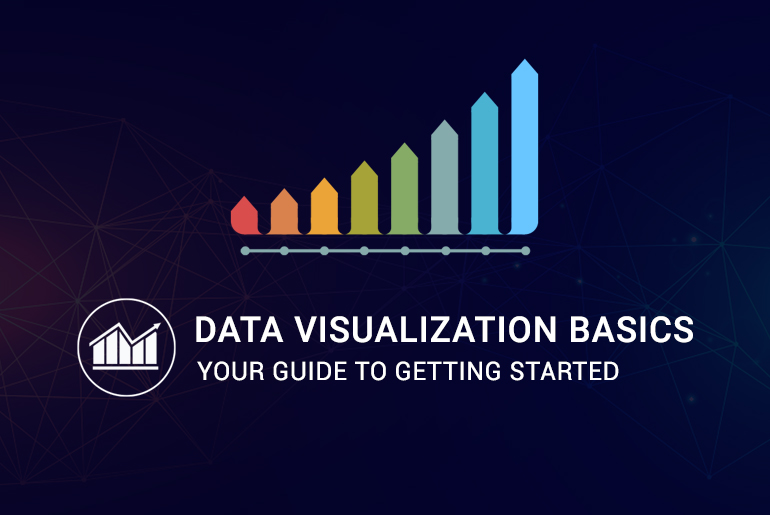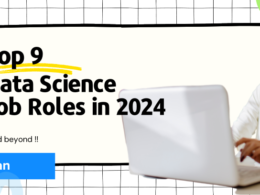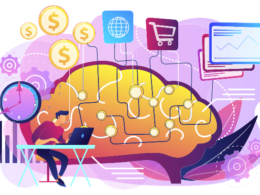Do you know that you have already performed data visualization?
Let’s refresh your memories a bit. Remember in school you had to draw graphs and pie charts after solving any mathematical equation or problem – well, that’s data visualization!
To put it simply, it is the graphical or visual representation of data via graphs, charts, maps, etc. And since creating data visualization of huge data sets manually slows down the process and makes the analysis a victim of human errors, we now use data visualization tools to get accurate analysis as well predictions.
In this article, you will get to know everything about data visualization, data visualization tools and packages, why they are necessary, and how you can get started with data visualization processes.
What is Data Visualization?
Here’s how the Accredian Research Team describes Data Visualization: Data Visualization is the art of representing data in a pictorial form that is concise, unequivocal, and easy to understand.
Graphs, Columns, Pie charts, Venn Diagrams, Colour Maps, Network Maps, Trees, Frequency Polygons, Box-and-Whisker Plots; Line, Surface, and Volume Scatter Plots and so on are examples of data visualization models.
Sound familiar? No matter what your background, the chances are that you have used one or more of these data representation forms at school and at your workplace!
Why Do We Visualize Data?
Now that we know what data visualization is, we return to the question, why do it?
Primarily, Data Visualisation serves the following purposes:
1. Makes Data more Understandable and Accessible
Properly visualized data makes even large chunks of data much more understandable in context.
This makes the crux of the data more accessible to people that it concerns.
For example, a plot of Sales records vs. time for each commodity sold by an organization might provide an excellent insight into how things are at present.
2. Analyses Data to Solve Specific Problems
Many problems, such as troubleshooting and optimization issues require a thorough analysis of data sets that are relevant to the case.
In their raw form, most data is available in the form of tables or CSV format.
Depicting them innovatively in visual format often makes it possible to spot discrepancies and anomalies in processes that lead to new developments.
Data Visualization: Where it all Began…
Although pre-historic examples of data visualisation exist, the actual story begins with the invention of the coordinate planes.
Hence, René Descartes, the founder of the Cartesian XY plane, can be named as the founder of data visualization.
While data visualization was consistently used as a tool by governments, academicians, and businesspersons right through history, it boomed with the advent of computers, which made the analysis of massive data sets not only possible, but also simple!
In today’s world, data visualization using computers is a primary requirement for all disciplines, and can be found not only in science and commerce, but also the deepest reaches of art and culture.
The Need For Data Visualization? Explained with Real World Examples!
Data visualization has a near-infinite number of use cases.
However, some sectors that are most influenced by and dependent on data visualizations are science and technology, finance and marketing, data science, and business intelligence.
Work in these disciplines begin and end with generation, visualization, and interpretation of data.
The Accredian Research Team lists below two examples from two different sectors of everyday life to show the importance of the discipline.
● Network Maps: Making London Underground Possible!
If you live in a metropolitan city with a bus, tram, or tube route, you’re going to realize the significance of network maps in our lives.
Imagine where one would be without maps such as the one below?

The only alternative would be to come up with a list of possible permutations and combinations of routes from that logjam, something that would take hundreds of pages and render London Underground impossible to use!
This kind of plot, also known as network maps, are useful not only in the transport sector, but in any sector where a large number of interconnected things are present.
For example, in a Big Data cluster, a similar kind of map exists to show the data flow pipelines in the system.
Another prominent example can be, Facebook’s record of user information and interactions that form a similar map enabling it to come up with likely friend suggestions and show you relevant ads!
● Scatter Plots: Illustrating Global Warming
We selected this scatter plot for our second example because it is possibly one of the most important plots that exist in the present age – it’s a plot that shows how global temperature is increasing beyond the expected limit in recent years.

Scatter plots such as these are excellent for analyzing how Y changes with X – in this case, how Temperature anomaly changes with time.
Note the various tools of visualization used in the plot – the red line is a running average of five years of temperature variation that gives us a less rigorous but more “overall” view of what’s going on.
Scatter plots are one of the most commonly used data visualization tools. A simple Google search would cough up millions of results of the plot being used to represent sales figures, evolution of road accidents, or the growth of internet users over the years.
Knowing how to build a decent scatter plot is possibly the most fundamental and vital tool in a data analyst’s arsenal.
7 Common Ways of Visualizing Data
There are innumerable ways of visualizing data, and it’s almost impossible to cover them all in an article.
However, we listed some of the more common forms of data visualization for you in the table below:
| Form | Use Case | Example |
| Bar Charts | Great for comparison of discrete values | Analyzing how much revenue a list of companies have generated in a year |
| Frequency Polygons | Observing the trend of a particular variable with time | A depiction of how many people visit a restaurant on each day of the week |
| Scatter-Plots | Can be one, two, or three dimensional. Great for observing the relationship between two variables | To see how the number of phone sales changes with variation in pricing |
| Network Maps | Analyzing the dynamics of large and complex networks | Figuring out a cluster of people most likely to buy your product from a network map of Twitter users |
| Gantt Chart | Monitoring the progress of a task or project | Most business case or research proposals are incomplete without a Gantt chart showing how the project is expected to evolve |
| Tree Map/Pie Chart | Great for depicting percentages | Percentage break-up of usage of memory on your phone |
| Color Map | Depicting the change in the value of a variable over space | Measuring how much heat is produced in various parts of an internal combustion engine during operation |
Top Data Visualization Tools That You Should Learn
Data visualization tools can be dedicated or generic.
Dedicated tools are ones that have been designed for a specific audience keeping in mind a specific purpose. On the other hand, generic tools may be used by anyone regardless of discipline.
Top 2 Dedicated Visualization Tools
1. QlikView
QlikView, manufactured by the software company Qlik, markets itself as a “business discovery platform”.
The key potential of Qlikview is its ability to generate graphics that visually analyse the relationships between two or more units of data.
Qlikview has the ability to process data in-memory which makes it an excellent tool for quick-and-dirty processing of data.
Coming to sources, Qlikview can read data from virtually any source, be it CSV files or SQL databases.
It can also combine data from multiple sources (data integration) and generate composite data sources for analysis.
It can process data and generate reports directly based on the requirements of a specific project.
The target audience of QlikView are businesses that are looking to get a thorough understanding of the data generated by their endeavours.
2. Tableau
Not unlike QlikView, Tableau is a Business Intelligence tool for visually analyzing data.
Users can create and distribute an interactive and shareable dashboard, which depict the trends, variations, and density of the data in the form of graphs and charts.
Tableau can connect to files, relational and Big Data sources to acquire and process data.
The software allows data blending and real-time collaboration, which makes it very unique.
It is used by businesses, academic researchers, and many government organizations for visual data analysis. I
Packages and Other Generic Data Visualization Tools
1. MS Excel
Excel from Microsoft Office is undoubtedly the most common data visualization tool in the world.
No matter what your background, chances are that you have some experience with MS Excel from high school or university.
Excel, with its well-recognizable spreadsheet format, is a very fundamental tool for data analytics and contains basic in-built visualization tools.
However, a major shortcoming of Excel is that customized data visualization is difficult, and this makes it a bad candidate where the work you’re doing has specific requirements.
2. MATLAB
MATLAB from MathWorks is well-known among programmers and mathematicians for its powerful library for numerical analysis, genetic algorithms, machine learning, and data visualisation.
It is the go-to software for complex plots such as 3D surface plots, colour-mapped contours, and so on.
MATLAB is used alike in academia and the industry.
The only shortcoming of MATLAB is that it is not free – the package is expensive and hence difficult to access for low-budget ventures.
Moreover, being a proprietary software, it is not open-source and hence, new functionality cannot be manually added to MATLAB by a random user when required. Nonetheless, it remains one of the most commonly sought-after data visualisation tool when the datasets are complex.
3. Matplotlib
Matplotlib is a free and open-source package for the programming language Python.
It can be downloaded via pip with any python installation and has pretty much all the data visualisation functionality of MATLAB for no charge!
While matplotlib alone is almost never all that is required to plot data in Python, hundreds of support packages are available making it a strong candidate for data visualisation.
For example, when it comes to Machine Learning applications, the combination of Numpy, Scipy, Scikit-Learn, and Matplotlib is considered to be golden!
The package gets even more prominence from the fact that most software that deal with data analytics, such as Big Data platforms like Hadoop and Spark, all support Python.
4. Origin/GnuPlot
Origin and GnuPlot are both platforms that are primarily used in academia for the depiction of scientific data.
The difference between the two is that GnuPlot is free while Origin is not.
Nonetheless, both packages offer powerful data visualisation tools that have become an intrinsic part of the scientific community.
Almost all scientific publications in national and international journals around the world use data visualized by them.
Getting Started with Data Visualisation
If you’re just starting with data visualisation, it may be useful to begin with reading the background of the discipline with some books.
For example, Edward Trufle’s “The Visual Display of Scientific Information” is considered to be a bible for beginners in data visualisation and is recommended as study material in a lot of university sources.
For a more hands-on approach, the articles at TutorialsPoint serve as an excellent starting point for intermediate users of data visualisation tools and techniques.
For business professionals looking to enhance their data visualisation skills, “Storytelling With Data: A Data Visualization Guide for Business Professionals” by Cole Nussbaumer Knafli is an excellent starting point.
Final Thoughts
This article served as a beginner’s first glance at data visualization, what it is, why it’s important and what are some of the ways of doing it. It is the first of a series of articles on data visualization, and the forthcoming articles will deal with the art in the light of business analytics and intelligence.
Have you used any of the data visualization tools mentioned above? Which did you find the most suitable for your needs? Do you think we left out any of the big guns? Let us know in the comments section!
And if you want to master Data Visualization techniques, give us a shoutout right here.





